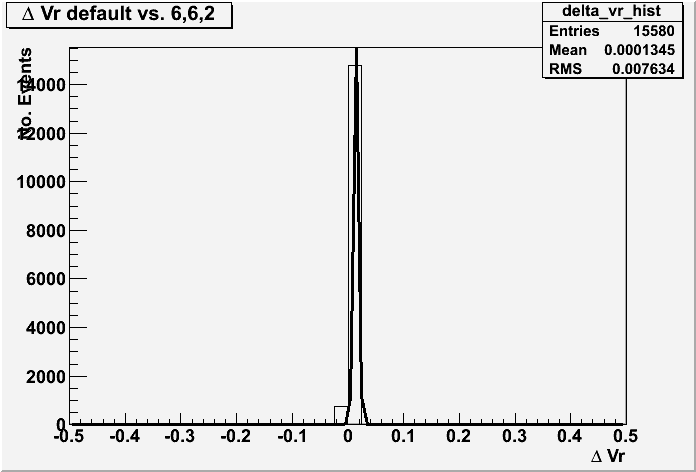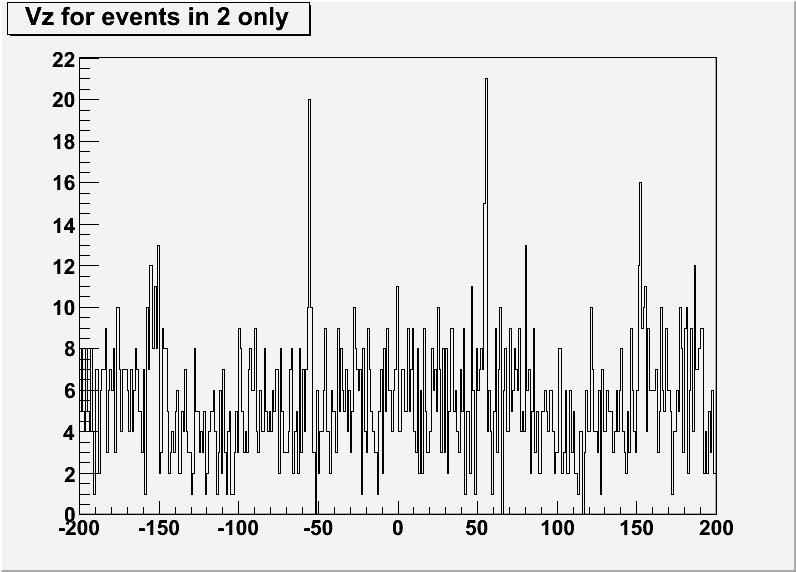Vertex Parameter Study - 19.6 GeV
We spent most of the week fighting bfc and the scheduler, but finally we were victorious!
However, after a day of running, our first choice for a sample run (12113006) looked like this -- 665(RZN):

The Vz distribution looks highly skewed, for both the beamspot (bottom line) and the "halo" events (upper line):

Due to the skewed vertex distribution and the beam spot being visibly on the beam pipe, we decided that the tune must have been bad this early in the run. Therefore, we punted on this day.
We chose a new run (12120030) that looks much better -- 665(RZN):

And it has a very nice beam spot:

This is the Vz distribution for events in the beamspot (Vr<1 cm):

The distribution looks as expected, only borader, but thats not surprising at lower energies. If we look at the remaining events (Vr>1 cm) we can clearly see the expected distribution from the beam pipe, including the lower background rate from the beryllium vs aluminum segments:
.gif)
This dataset looks much cleaner. However, we have yet to finish running the bfc over the new daqs with the modified 662 setting, so we can't compare the two yet. However, we have can make two observations so far:
1) At least early on in the 19 GeV run, the beam optics were a bit wonky, so researchers need to be cautious with their QA.
2) Our second choice for a sample run had much better optics with a very well defined beam spot away from the beam pipe.
One last thing to note is that we do have a high rate of multiple vertices:

I've only analyzed the primary ones so far, but I'll take a look at higher order ones. Also, having the 662 to check against will help.
Adding in the QA plots for 662(RZN).... We look first at the indexed 0 and 1 vertices.
The beam profile
.gif)
Comparing to the beam line....
.gif)
.gif)
So, we can see that there are AuAu events along a wide range of Z. And in the Vy vs Vz plot, you can make out parts of the SVT support structure at 50cm.
Looking at only the indexed 0 vertex:
Beam profile....
.gif)
And looking at comparisons to the beam line:
.gif)
.gif)
You can see the SVT support structures, if you squint a little, at 50cm.
The total distribution in Z of vertices
.gif)
the black is both index 0 and index 1; Red is index 0 alone; blue is index 1 alone.
Comparing the z-vertex position of the index 0 and index 1 vertices, a (delta)Vz
.gif)
Looking at the number of vertices found in events

If we put in some geometric cuts, standard as seen in the plot titles we have

 vv
vv .gif)
Comparing the Vr of 662 vs 665 shows no appreciable pull from one to the other:

Doing a counting experiment, we found that about 82% of the time, 662 and 665 found the same primary vertex. 6% of the time, they both found vertices, but the primaries were not the same (and there was no correllation between the vertex positions leading us to believe this is just a reranking issue). 12% of the time, 662 found a vertex when 665 didn't. Of these, about half are in the beamspot.
Vz of events in 662 only. We see some detector structure.

Vxy for events found only in 662:

From this study, we can draw the following conclusions:
- There is little appreciable difference between the 662 and 665 vertex settings in the 19.6 GeV environment
- 662 will find about 6% more good AuAu events, but will might move good vertices from the rank0 to rank1 spot
- 665 will be a faster production due to the smaller scan space
- Both settings will do a fine job at locating Au+Au events
- akesich's blog
- Login or register to post comments
